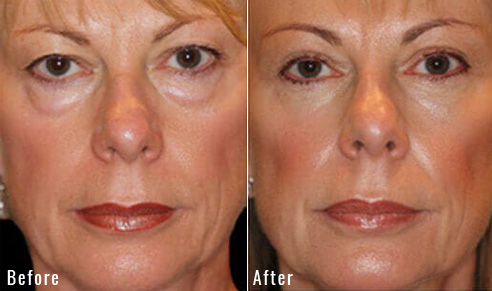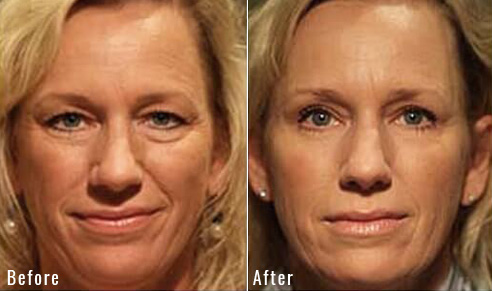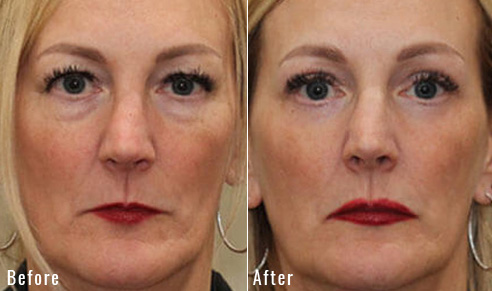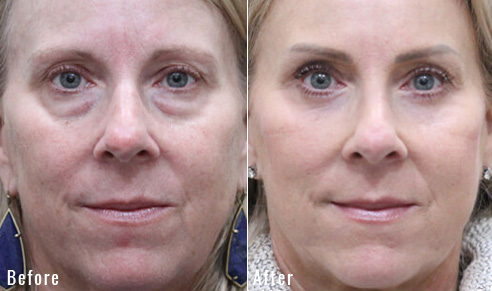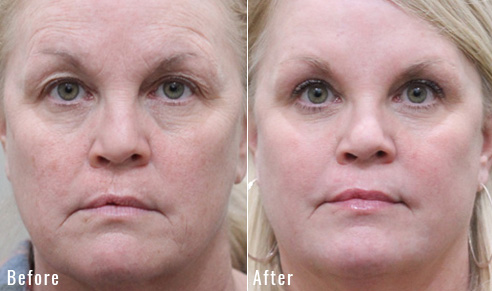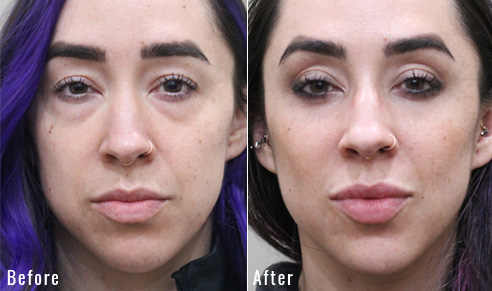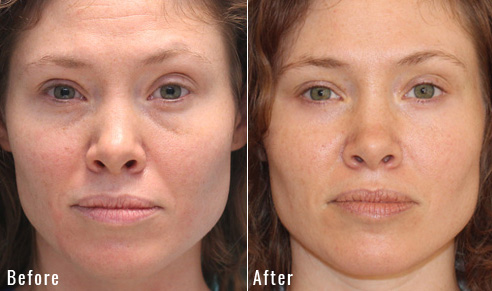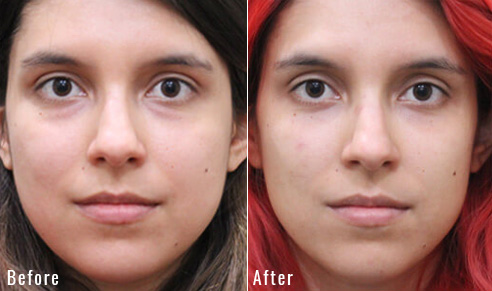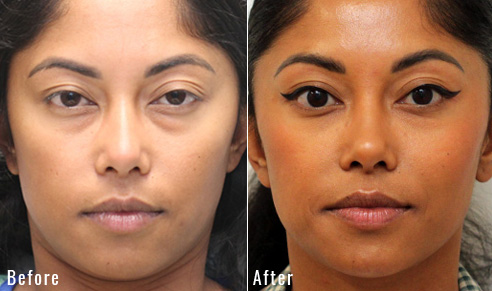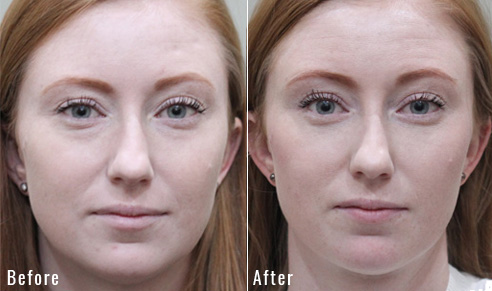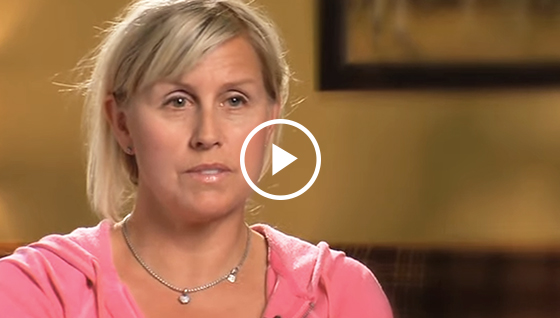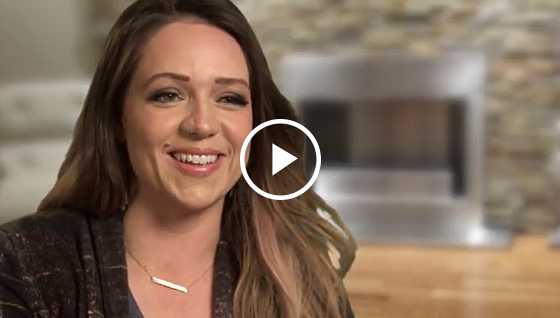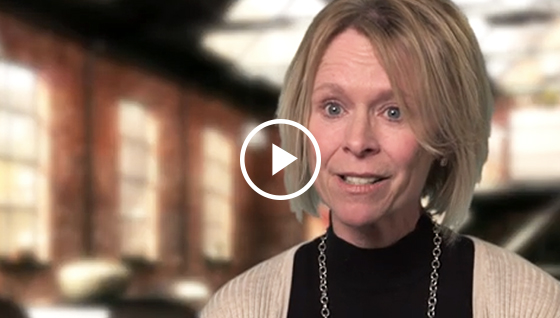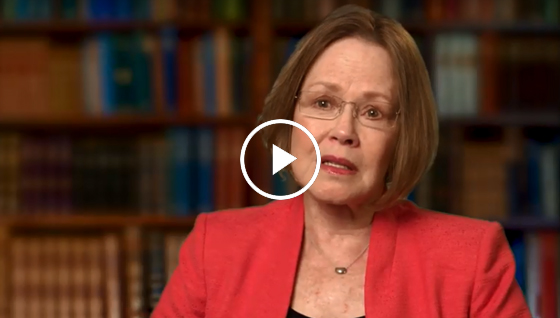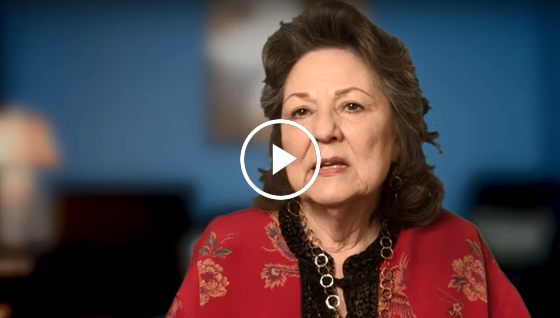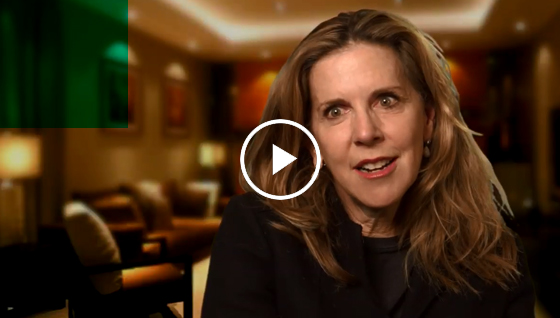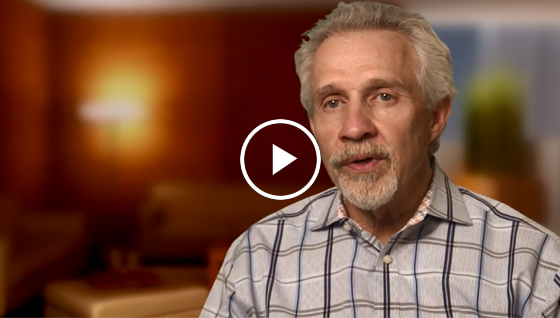Eyelid Surgery
Welcome to McCracken Eye and Face Institute, the premier destination for expertly designed eyelid surgery in Denver. Women and men across the state visit Dr. McCracken’s practice for upper and lower eyelid surgery to restore a youthful, alert, and dynamic appearance. Choose a single procedure or combine both to address multiple signs of aging around the eyes with natural-looking results that show why Dr. McCracken is the go-to specialist across Colorado.
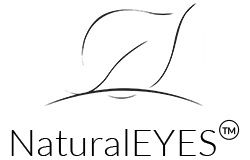
Intro to Eyelid Surgery
Eyelid surgery, aka blepharoplasty or an eyelid lift, is an outpatient cosmetic procedure that rejuvenates the eye area. We provide two main variations: upper eyelid surgery and lower eyelid surgery. Each procedure targets unique concerns with the shared goal of creating a rested, restored look. Dr. McCracken’s patented Natural EYES™ approach blends precision with aesthetic vision. Your results will stand out, but in a balanced way that looks fully natural.
Upper Eyelid Surgery
Upper eyelid surgery focuses on removing excess skin and fat from the upper eyelids. By carefully tightening these delicate structures, Dr. McCracken minimizes the appearance of bagginess and puffiness in the upper eyelid region, giving you a younger, fresher appearance.
Lower Eyelid Surgery
One of the first places where signs of aging appear is the under-eye area. Even as young as 30 years, patients may notice loss of volume, uneven texture, and bags or dark circles. These changes can evoke a tired, puffy, or aged appearance. Lower eyelid surgery adjusts the under-eye tissues to restore a rested and alert look to the eyes.
I cannot recommend Dr. McCracken and his team highly enough! From my initial consultation to my follow-up appointments, the entire experience was seamless, professional, and incredibly positive. Everyone on the team was attentive, compassionate, and made me feel completely at ease throughout the entire process.
-Baileigh Thaden
Which Eyelid Surgery Is Right for Me?

Upper Blepharoplasty
Targets: Excess tissue in the upper eyelids.
Best for Patients Wanting to:
- Remove loose or sagging eyelid skin that creates “hooding” or folds around the eyes
- Remove excess fatty deposits that cause puffiness
- Improve the appearance of lines and wrinkles in the upper eyelids
- Restore upper eyelid symmetry
- Tighten a severely drooping eyelid that impairs vision
Lower Blepharoplasty
Targets: Under-eye signs of aging.
Best for Patients Wanting to:
- Eliminate puffiness under the eyes.
- Improve the appearance of under-eye “bags.”
- Eliminate dark circles under the eyes.
- Remove and reshape fat to restore the eyes to a more youthful appearance.
- Smooth away lines and wrinkles in the lower eyelids.


Building a Combination Procedure
Signs of aging rarely stay in one area, making a combined procedure ideal for many patients. We can readily combine upper and lower eyelid surgery into what is called quad blepharoplasty. Doing so requires only a single surgical visit, sparing you from multiple periods of downtime.
As a board-certified oculoplastic surgeon in Denver, Dr. McCracken also offers other facial procedures you can combine with eyelid surgery. Maybe you want to improve skin texture. Or perhaps heavy brows have made you look tired. Dr. McCracken can recommend additional procedures for each concern, opening the door for enhanced results.
Top choices include:
- Brow Lift: Remove excess skin and smooth out wrinkles in the brow area.
- Midface Lift: Repositions the fat pads above the cheekbones so they no longer sag.
- Laser Therapy: Revitalizes skin tone and texture while also smoothing away wrinkles.
- FaceTite: Contouring for the face or neck with minimal downtime.
Very pleased with the results
I was pleasantly surprised that my fillers procedure were pain free….
– Michaela

Lower Eyelid Surgery
As a natural part of aging, the skin around the lower eyes can become loose, and the fatty deposits can bulge. Time, heredity, and environmental factors can cause the skin and fat of the lower eyelid to become wrinkled and baggy. The fat of the lower eyelid can result in a tired, puffy, and aged appearance.

How can lower eyelid
surgery help?
Our patients report being pleased with how our service restores their eyes to a youthful look. Among the things our service can help fix include:
- Eliminate puffiness under the eyes
- Improve the appearance of “bags” under the eyes
- Remove and reshape fat to restore the eyes to a more youthful appearance
- Improve the appearance of lines and wrinkles in the lower eyelids
Benefits of Eyelid Surgery with Dr. McCracken
Dr. McCracken has provided eyelid surgery for the Denver community for years, continually elevating his approach with the latest techniques and an individualized method. Our patients choose Dr. McCracken for eyelid surgery for reasons such as:
- Patented NaturalEYES™ Technique: Eyelid surgery should look amazing but never like you actually had surgery. That’s the philosophy behind Dr. McCracken’s NaturalEYES™ technique—subtle changes for vivid results.
- Full Recovery Support: Dr. McCracken provides attentive follow-up for every patient throughout the recovery process. He tracks your recovery and provides clear information with unique tips based on his years of experience.
- Hidden Incisions: Incisions are always carefully placed and kept to a minimum. By hiding incisions within the eyelids’ natural creases, your results shine through, not your scars.
- Results You Feel: Eyelid surgery creates cosmetic changes, but they have a real impact on how you feel. Dr. McCracken builds every procedure with the goal of helping patients feel just as alert and refreshed as they look.
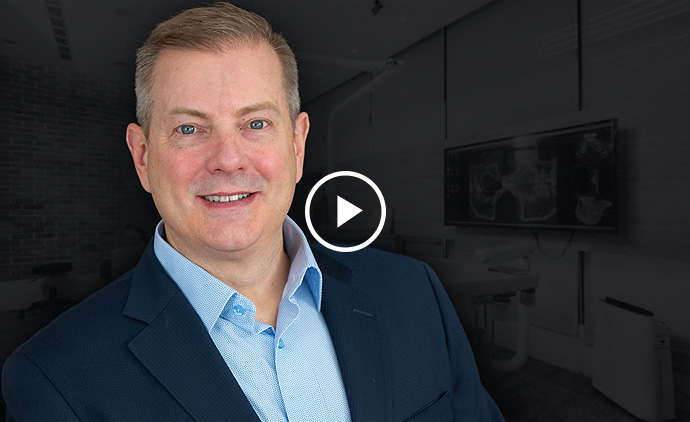
The Blepharoplasty Procedure: a Step-by-Step Overview
Consultation & Preparation
Before undergoing any procedure, Dr. McCracken will thoroughly consult with you. He works with you to assess your specific needs and build a clear picture of your desired outcomes. During this consultation, you can ask questions and address any concerns about the procedure. We will go over any potential risks so you can make a fully informed decision. We also review your medical history to ensure no risk factors are present.
With your surgery date scheduled, you can begin preparing for the procedure. These steps might vary a little between patients but typically include:
- Arranging for a ride to and from surgery
- Obtaining any necessary bloodwork or tests
- Treating any active eye conditions or infections
The Big Day: Your Procedure
- Check-in: Dr. McCracken meets with you to ensure you are ready for surgery. Feel free to ask any last-minute questions or ask for clarity on any post-procedure points.
- Anesthesia: Modern surgery is painless. Dr. McCracken typically uses local anesthesia to numb the entire treatment area. You may also receive oral medication to ease anxiety and improve comfort. In cases of general anesthesia, Dr. McCracken operates in a fully equipped surgery center alongside a board-certified anesthesiologist.
- The Incisions: Dr. McCracken creates tiny incisions in strategic locations. His technique aims to minimize incision size while maximizing efficacy. Exact placement is carefully considered and adapted for your unique eyelid structure.
- Working with the Tissues: Via the incisions, Dr. McCracken removes, repositions, or adjusts target tissues to craft the desired result.
- Wrapping Up: Dr. McCracken closes the incisions with sutures or adhesive as appropriate. You can then spend some time in the recovery room until ready to return home.
After the Surgery: Recovery and Aftercare
The Timeline
- Initial Recovery: Expect about 1 to 2 weeks of downtime away from work and your routine. Focus on recovery and post-op care to improve swelling and discomfort.
- The Middle Period: After 2 weeks, you can begin resuming light activity and return to work. Continue to avoid strenuous activities for the next few weeks.
- The Full Return: Based on your follow-up visits, Dr. McCracken will advise you on when you can return to your full routine, including strenuous activity. Usually, your full return can happen between at 4–6 weeks after eyelid surgery.

Dr McCracken explains how to put ointment in the eye after eyelid procedure.
Recovery Overview and Tips
The recovery period starts with rest and entails attentive self-care. With how delicate the eyelids are, ensuring a smooth recovery goes hand in hand with seeing optimal results. Dr. McCracken provides each patient with materials outlining every step of recovery with clear tips for promoting a safe, timely healing time. Some key elements include:
- Resting (and then Resting Some More): After surgery, your biggest task is to do nothing. Simply lie with your head elevated and let your body’s healing mechanisms get to work.
- Attending Follow-Up Visits: These quick visits let us check that your recovery is moving along properly. If any issues arise, we can address them before they become problematic.
- Managing Discomfort: The first few days after eyelid surgery can involve some pain. However, over-the-counter medication is usually sufficient for managing it. After that first hurdle, discomfort should notably improve each day.
- Applying Compresses (Warm & Cold): Cold compresses are your friend for the first 48 hours. They help manage swelling from day one. After your swelling fades, warm compresses take the stage. Warm (but NOT hot) compresses can encourage blood flow, which can help your tissues heal. Always apply any compresses gently!
- Lubricating Your Eyes: Using specialized eyedrops to keep your eyes moisturized is a small but important step to avoid irritation.
Schedule Your Consultation
Open the door to feeling younger and more alert by starting with a consultation at Dr. McCracken’s practice in Denver. Call (720) 729-3988 or use our online form to set up a one-on-one meeting to see if eyelid surgery is right for you.

Eyelid Surgery FAQs
Any surgical procedure will have associated risks. However, you can minimize these by working with a board-certified surgeon like Dr. McCracken and following all post-op instructions carefully. These risks can include:
- Infection
- Bleeding
- Swelling
- Scarring
- Eyelid retractions
- Under/overcorrection
Dr. McCracken has dedicated his entire career specifically to oculoplastic surgery. From intensive training to years of building a track record of success, his practice is the go-to center in Denver for safe, transformative surgery. His qualifications include being:
- Among a handful of members of the American Society of Ophthalmic Plastic and Reconstructive Surgery
- A fellow of the American College of Surgeons
- A member of the American Academy of Cosmetic Surgery
- Teacher at the annual American Academy of Ophthalmology meeting
- Author of a number of textbook chapters and articles on surgical and nonsurgical techniques
- Award-winning trainer of doctors at UC San Diego and the University of Colorado Health Sciences Center
A single procedure will create all the structural changes needed for years of results. However, you will first need to get past the recovery period. The swelling and bruising associated with healing will need to fade before your new look shines through. This happens in two main stages. First, the initial swelling fades after about a week. At this point, you should already start to see your results. However, minor residual swelling takes longer to fade. While this will not mean you look “swollen,” it does slightly influence how the tissues rest in your eyelids. As it fades, your final results will settle into place.
Result duration will vary, depending on factors like age, health, and lifestyle. With that in mind, upper eyelid surgery results typically last 5–10+ years. Lower eyelid surgery results tend to last longer, regularly fostering a youthful appearance for 10+ years. Nonsurgical touchup treatments can help stretch the longevity of results.

